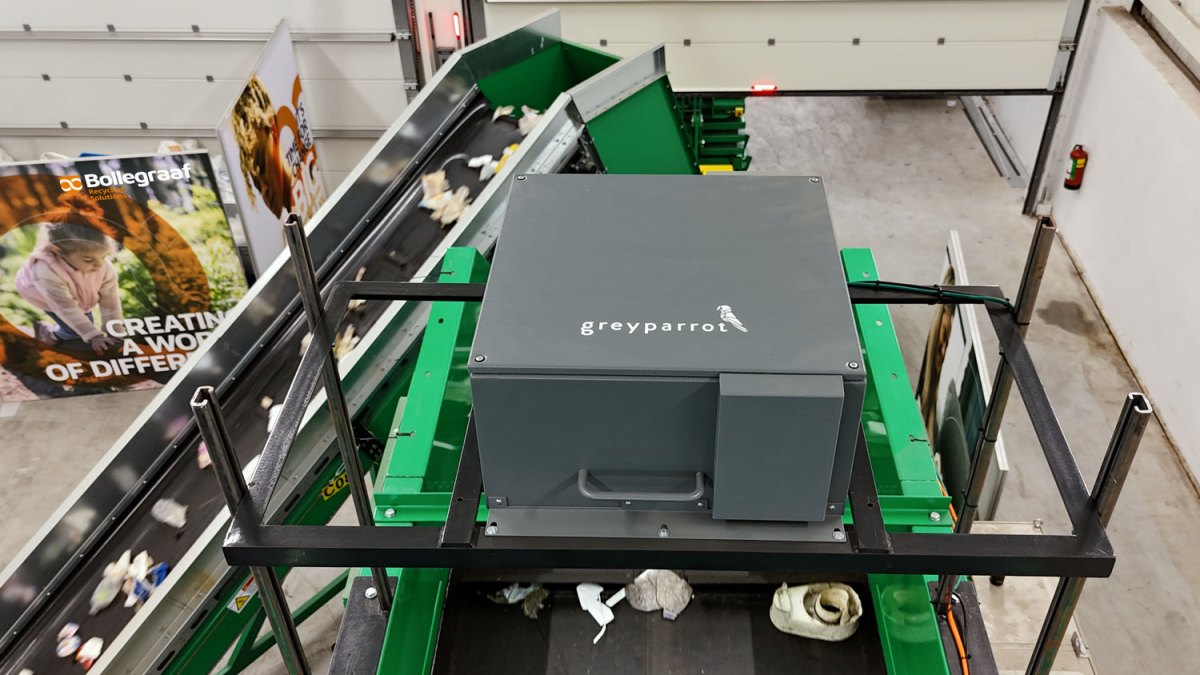
[ad_1]
In another sign of the scramble to accelerate the uptake and transformative potential of artificial intelligence, Dutch recycling giant Bollegraaf Group is making a strategic investment in UK AI startup Greyparrot, which uses computer vision for waste analytics.
The veteran manufacturer of MRFs (Material Recovery Facilities) and “turnkey” recycling systems — which was originally founded as a baler machinery maker, all the way back in 1961 — has been dabbling in AI itself in recent years, opening an innovation test center in its native Netherlands in 2021 and recruiting an in-house AI team to work on integrating AI analytics with its recycling machinery that had led to some commercial rollouts.
London-based Greyparrot, meanwhile, a 2019-founded computer vision startup (and TC Disrupt battlefield alum), has spent nearly five years developing and applying AI to municipal waste management processes to produce what it bills as “waste intelligence” — aka, data on binned plastics and other tossed items. This is critical for improving the quality of the product for recyclers to sell. The tech can also be used to recover valuable (i.e. recyclable) materials from mixed/contaminated waste streams that might otherwise end up in landfill or be incinerated.
The second big puzzle-piece in Greyparrot’s mission to apply AI to shrink the world’s waste problem through smarter and more efficient recycling is to move from being a data producer to a decision-maker — as the AI-engine driving sorting and recovering machinery to be more efficient. This too is critical as the world continues to produce more (not less) waste, dialling up the requirement for more intelligently managing the stuff we throw away so our societies don’t drown under a growing mountain of trash.
Add to that, in Europe at least, the introduction across several recent years of a number of regulatory requirements on packaging and other producers to use more recycled materials in their products are increasing incentives — and stabilizing demand — for better quality recycled outputs to sell them.
While the bulk of Greyparrot’s deployments so far have involved retrofitting its AI devices to existing recycling plants, it expects future waste recovery facilities to be built from scratch with AI embedded from the start — and it wants its tech (the Greyparrot Analyzer, as its AI camera hardware unit is called) to be the brain of those operations. So it’s working towards a thesis of rising automation of waste management — where AI-powered data-driven analytics get more and more deeply embedded in how recycling facilities operate as a result of rising demand to optimize recovery rates, yield better quality outputs and squeeze how much waste gets, well, wasted.
Greyparrot has been building APIs (aka Greyparrot Sync) for integrating with its customers’ sorting and recovery facilities’ machinery for a while. But it says the motivation for the new partnership with Bollegraaf is to accelerate this integration (or digitization) process — as the latter brings decades of expertise in machinery and robotics to Greyparrot’s AI-powered waste recovery party.
“The big vision with Bollegraaf is really accelerating and leading on the digitization of the waste sector,” Greyparrot CEO and co-founder, Mikela Druckman, tells TechCrunch. “Bollegraaf is one of the largest plant builders in the world — so building the whole infrastructure for waste management, all the recycling facilities, sorting facilities — and we are the leading AI waste analytics player right now. So really combining forces is allowing us to go much faster to scale that digitization and, ultimately, go towards a future where we’re building the smart MRFs that are fully adaptive, automated, and are really transforming the waste industry by allowing a lot more efficiency, a lot more recovery and higher quality output of those materials.”
AI team transfer as part of $12.8M strategic investment
The strategic AI partnership the pair are announcing today includes the transfer of Bollegraaf’s own AI vision business to Greyparrot — comprising a team of six people. Greyparrot is acquiring everything related to the vision systems it had developed, per Druckman — “the AI models and also the team working on it”. The personnel it’s acquiring will remain in the Netherlands — where the UK startup will also (therefore) be opening its first office in mainland Europe.
As part of the deal, Bollegraaf is also making a cash investment in Greyparrot — which they’re reporting as having a total value of $12.8M — to obtain a non-controlling, non-majority stake. (NB: The startup last raised a $11M Series A round back in May 2022, following a $2.2M seed two years before that; and says it’s not currently looking to raise a B round.)
Druckman said they’re not disclosing the mechanics of Bollegraaf’s investment (nor the size of the stake) but she confirmed there’s a 50:50 split between the cash investment portion and the acquisition value being put on Bollegraaf’s AI business unit that’s transferring over as part of the deal. (So the going rate for acqui-hiring AI engineers looks to be over $1M a person.)
As a result, Greyparrot will be taking over the running of Bollegraaf’s existing AI deployments. But she said it will review these, on a case-by-case basis, to determine whether to transfer the implementation to Greyparrot’s tech (or maintain it as is). While all future AI deployments across Bollegraaf’s plants will of course use Greyparrot’s kit.
The terms of the partnership agreement will see Bollegraaf serving as a worldwide distributor and strategic partner for Greyparrot’s AI camera system hardware — which is currently deployed to extract analytics from waste streams and recycling plants across 14 countries, installed inside some 30-40 facilities. (Europe remains its main region for customers, where the startup says its tech currently reaches about 70% of the market, though it has a foothold in the US market and expects the new strategic partnership to help it accelerate its reach over the pond.)
The AI that Bollegraaf had been developing had the same goal as Greyparrot’s system, according to Druckman, who described the two teams as having built “a lot of complementary” technology. Joining forces will thus enable the startup to step on the gas in advancing its AI. “Leveraging some of the R&D that they they have already done, will help us accelerate [development] on our side,” she suggested. “We’re always working on developing new versions [of our Analyzer hardware] and upgrading that. So that’s really part of our roadmap.”
“This was very important for Bollegraaf,” she added. “They had been doing some R&D for the last few years. And that by partnering with a player like us, this would also accelerate their product development and technology development — and, from our side, the commercial distribution and scale as well. So it was really a win-win situation.”
Druckman also emphasizes there’s no change of strategy/business model on its part, flowing from the investment. Greyparrrot will continue to sell its AI-powered waste analytics to other MRF makers, even as it gets to benefit from tapping Bollegraaf’s global scale. (The latter reports some 400+ MRFs and 3,100 recycling and sorting systems “designed & installed worldwide” — with a global footprint that laps the globe, stretching from Northern American, through Europe and Asia to Australia.) And, of course, the UK startup won’t be getting into building any physical recycling/sorting machinery or robotics; it’ll remain laser focused on AI.
“A big part of the partnership is obviously — one — the commercial distribution and the scale that they’re able to provide because of their network they’ve built,” she said, summarizing the drivers for the deal. “So plugging into those retrofits and other new builds that they’re doing that will be equipped with our Analyzers and AI and digital capabilities.
“The second big thing is the integration of that data with our APIs, Greyparrot Sync, into their control systems, into different types of sorting systems… And again, slowly and surely building towards that fully automated, smart MRFs that we’re talking about. But we will be, basically, launching products together — in terms of combining our data and the Analyzers, and also connecting with their machinery and their systems that they already have.”
Commenting in a statement, Edmund Tenfelde, CEO of Bollegraaf Recycling Solutions, added:
With 63 years of industry experience, Bollegraaf continues to be a global leader in fully-automated innovative turnkey recycling systems. The future is clear: to further increase recycling rates we need more insight and collaboration across the value chain. We have been looking to implement AI that can power fact-based and automated decision-making to provide our clients with a much more accurate overview of their waste composition and ultimately maximise their ROI. We are thrilled to make this strategic investment and partner with Greyparrot to bring waste intelligence to both upcoming recycling infrastructure deployments and existing facilities worldwide. We believe that Bollegraaf’s comprehensive knowledge of automation of recycling MRF operations, premium equipment quality, and unique engineering expertise empowered with Greyparrot AI systems represent the one-of-a-kind synergy that is destined for success.
Challenges on the road to system change
What are the biggest challenges when it comes to improving the efficiency of AI-powered waste processing as things stand? Plastics generally remain tricky, per Druckman, given the variety of types of plastics that may be present in a waste stream, with different levels of recyclability making it important to be able to distinguish between them as much as possible in order to be able to recover as much of the valuable (i.e. recyclable) plastics as possible.
“This is still where there’s work to be done,” she told us. “Mostly it’s about managing the fluctuations [between different types of plastics] and the hard to recycle plastics. There’s also other areas where Bollegraaf and other of our partners operate in that we’re also going into — so for example, electronic waste, construction/demolition waste, which have slightly different dynamics — but the core principle is the same: It’s a challenge of recognising the material and separating the material.”
“One thing that I think is important to mention is that there’s been a lot of focus in the last years on robotic arms in particular, to be a source of separation in combination with AI. From our point of view we have always seen that as one of the many options — and that’s why we built the technology and our infrastructure in a way that we have APIs that can integrate with robotic arms… but [our APIs] can also integrate with other types of separation systems as well. And that’s really important because there are many different types of mechanical separation systems… already enabling the separation of material that need to be digitised and connected with AI,” she added.
“This is the existing infrastructure — and we really believe that we have to leverage a lot of the millions of investment that have been done — and enhancing that and being able to plug into that infrastructure — versus just looking at, you know, very narrow use cases, with new hardware.”
Recycling is also, of course, only ever going to be a small piece of a much greater environmental challenge that waste poses. Druckman agrees this demands “system change” and a switch away from ever more extractive consumption to a circular economy where reuse, sustainability and longevity is designed and built it to products from the get-go to tackle the concept of throwaway waste at source. (“Basically reducing plastic use is critical to the solution,” she affirms. “Recovering and recycling — those alone will not solve the entire problem. We need to be doing those things in parallel.”)
But humanity is still very far from executing that 180-degree turn. So dealing with the trash we’re still making, via more and smarter waste management infrastructure looks like a critical stop-gap — to buy time to pull off the more radical swing in how we make and consume stuff. Hence Greyparrot argues we’re going to need a massive increase in waste management infrastructure, and AI-driven efficiency, to deal with the tsunami of rubbish baked in and inexorably coming down the pipe for us over the next few decades.
As it stands, the startup estimates just 1% of the waste passing through management facilities is monitored — while, even in “advanced” economies, it says around 40% of waste sorting is still done by hand — so the opportunity to scale an automation-friendly, efficiency-focused approach to waste management looks massive, assuming countries can be convinced of the need to clean up their act.
On that front Druckman argues the market is finally reaching a “turning point” — thanks to some key, change-driving regulations in Europe, including plastic taxes which put minimum requirements on packaging producers to use recycled plastics; and EPR (Extended Producer Responsibility) rules which force companies to address waste issues. She also flags more pro-recycling laws due to land over the next couple of years.
“That shift is happening,” she argued. “You’re seeing a lot more collaboration across the value chain and you’re also seeing a lot more commitments towards building that infrastructure… There’s still a lot to be done but I would say that we’re already seeing the building blocks of those policies, the regulation and also the commercial incentives to start being able to [drive the turnaround].”
AI’s ability to produce much more granular data — on what’s being thrown away, how much and where it’s ending up — also creates the opportunity for what Druckman couches as an extension of “post-consumption responsibility” onto the brands themselves — to have to address the afterlife of their products. Whether by choosing more minimal packaging that’s also easier to recycle or by contributing financing to the recycling and recovery of the materials used in their products. (Or, ideally, both.)
So, in other words, putting pressure on producers to minimize waste is another smart lever that data-driven insights — and AI-enabled transparency onto what’s being thrown away; and not recovered — can pull.
On this front, packaging design is, unsurprisingly, an area of interest for Greyparrot (as, indeed, it’s a burgeoning area of focus for a number of other sustainability-focused startups).
The UK startup suggests its analytics can be used by recycling professionals, plant builders, packaging producers, and FMCG brands to inform decisions and help them boost recycling efficiency, comply with recycling regulations, and improve recyclable packaging design. “Part of our vision is to utilise the waste intelligence and insights that we have on where the packaging is growing, and obviously our tech’s ability to be able to recognise the brand itself, to support information and better recycling of those materials and better packaging design,” added Druckman.
[ad_2]
Source link





